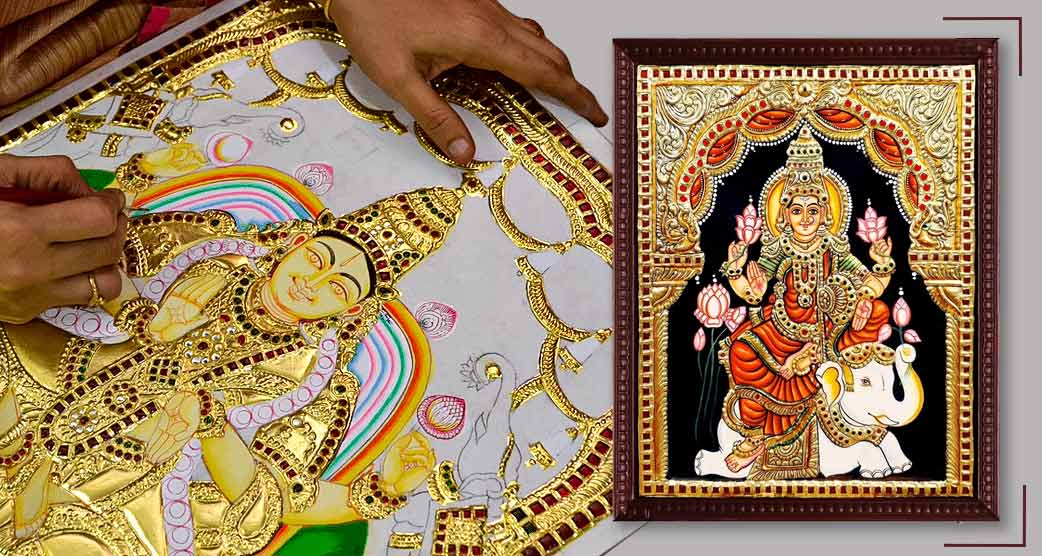
Tanjore paintings are the traditional folk art of Thanjavur (Tanjore), Tamil Nadu, India. As we all know, India is a country rich in culture and art. These Tanjore paintings are the perfect example of Indian folk art. Cottage9.com presents you with the beautiful and exquisite Indian art of Tanjore paintings.
Tanjore paintings are based on a variety of religious themes like Kodanda Rama Swami South Indian Tanjore Painting or Baby Krishna Tanjore Art. Tanjore art is a full-fledged form of painting that has a distinct style for depicting characters, their clothing, iconography, and other pertinent details.
Hindu Puranas were a significant inspiration source for the south Indian Tanjore paintings. The artwork was typically constructed around a central deity. And in the background, the Puranic event is being portrayed. Usually, the spouses, subsidiary deities, or other members of the divine entourage stood on each side of the principal deity.
Let us discover how these golden pieces of art are created by artists.
Tanjore paintings are based on a variety of religious themes like Kodanda Rama Swami South Indian Tanjore Painting or Baby Krishna Tanjore Art. Tanjore art is a full-fledged form of painting that has a distinct style for depicting characters, their clothing, iconography, and other pertinent details.
Hindu Puranas were a significant inspiration source for the south Indian Tanjore paintings. The artwork was typically constructed around a central deity. And in the background, the Puranic event is being portrayed. Usually, the spouses, subsidiary deities, or other members of the divine entourage stood on each side of the principal deity.
Let us discover how these golden pieces of art are created by artists.
Raw Material And Tools Used In Tanjore Paintings
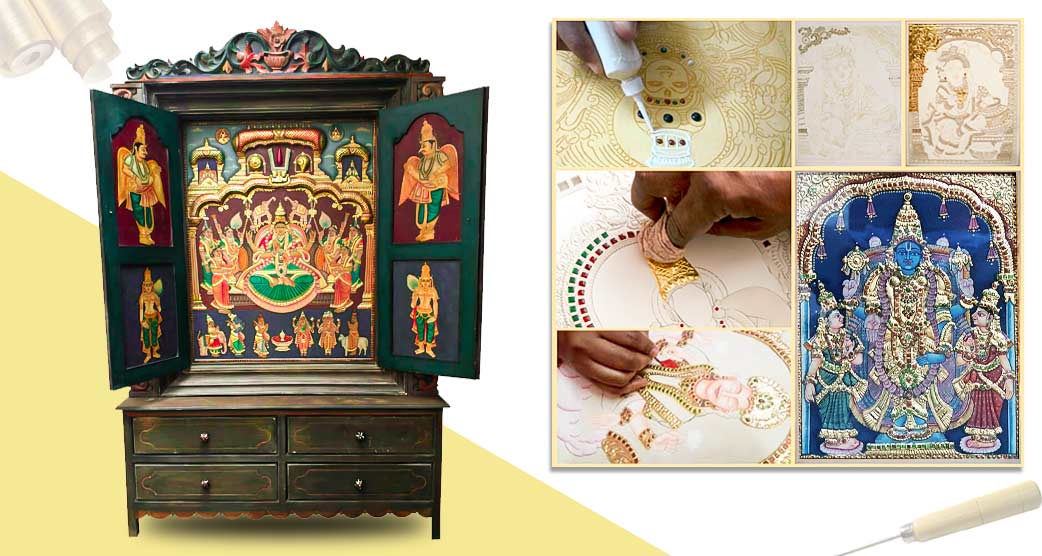
Wooden Plank: The Tanjore paintings are also known as “PalgaiPadam” where Palgai means a wooden plank and “Padam” means picture. Teak wood or Pazham Maram (jackfruit) is used to make the wooden plank.
Gum: Arabic Gum is a natural gum that is essential to the construction of Tanjore paintings in order to create muck paste and attach gold foil leaves to paintings. Traditionally, Nunga Passe (gum) is used to stick the gold foil to the canvas. This is a crystal-like substance that needs to be dissolved in water.
Chalk-Powder: In order to prepare the muck, chalk powder is used. Chalk powder is a kind of limestone that is a soft, white, porous sedimentary rock formed of the mineral calcite. It forms as a result of the gradual accumulation of microscopic calcite plates (coccoliths) released by a particular type of microbe called coccolithophores in rather deep ocean conditions.
Brush Set: Squirrel tail hair (Anil Vaal) was utilized to make the painting brushes used to create the Tanjore paintings.
Gada Cloth: Applied on a wooden plank, gada is a cotton fabric. The canvas for Tanjore paintings is made from cotton clothes.
Semi-Precious Stones: Diamonds and rubies have traditionally been used in embossing paintings, although other semi-precious stones are now employed.
The 22-carat gold foil : It was utilized to create the painting as the distinctive element of a Tanjore work of art. The gold leaf on the picture adheres with a local glue called Nunga Passe (gum).
Colors: Traditionally, organic vegetable dyes were used for painting, but today artificial paints are more common.
Emery Sheet: After adding the chalk powder to the board, this sheet is used to smooth it out.
Glass: To protect the painting, glass is positioned above it.
Gum: Arabic Gum is a natural gum that is essential to the construction of Tanjore paintings in order to create muck paste and attach gold foil leaves to paintings. Traditionally, Nunga Passe (gum) is used to stick the gold foil to the canvas. This is a crystal-like substance that needs to be dissolved in water.
Chalk-Powder: In order to prepare the muck, chalk powder is used. Chalk powder is a kind of limestone that is a soft, white, porous sedimentary rock formed of the mineral calcite. It forms as a result of the gradual accumulation of microscopic calcite plates (coccoliths) released by a particular type of microbe called coccolithophores in rather deep ocean conditions.
Brush Set: Squirrel tail hair (Anil Vaal) was utilized to make the painting brushes used to create the Tanjore paintings.
Gada Cloth: Applied on a wooden plank, gada is a cotton fabric. The canvas for Tanjore paintings is made from cotton clothes.
Semi-Precious Stones: Diamonds and rubies have traditionally been used in embossing paintings, although other semi-precious stones are now employed.
The 22-carat gold foil : It was utilized to create the painting as the distinctive element of a Tanjore work of art. The gold leaf on the picture adheres with a local glue called Nunga Passe (gum).
Colors: Traditionally, organic vegetable dyes were used for painting, but today artificial paints are more common.
Emery Sheet: After adding the chalk powder to the board, this sheet is used to smooth it out.
Glass: To protect the painting, glass is positioned above it.

Process Of Creating Tanjore Painting
Preparing The Canvas
The initial phase of the task involves cutting a wooden board to the desired size, covering it with cardboard, then stretching and adhering cotton cloth to the board using a local gum. The procedure of coating the fabric starts once it has solidly adhered to the board.
Then, a paste made by combining tamarind seed powder and chalk powder is applied to the cloth. Several coatings of this paste were put onto the canvas. To create a surface with a light sheen and good texture, this coated area is subsequently rubbed with an emery sheet and smoothening stone. The fabric board’s coating helps in shielding the painting from moisture and heat damage.
Then, a paste made by combining tamarind seed powder and chalk powder is applied to the cloth. Several coatings of this paste were put onto the canvas. To create a surface with a light sheen and good texture, this coated area is subsequently rubbed with an emery sheet and smoothening stone. The fabric board’s coating helps in shielding the painting from moisture and heat damage.
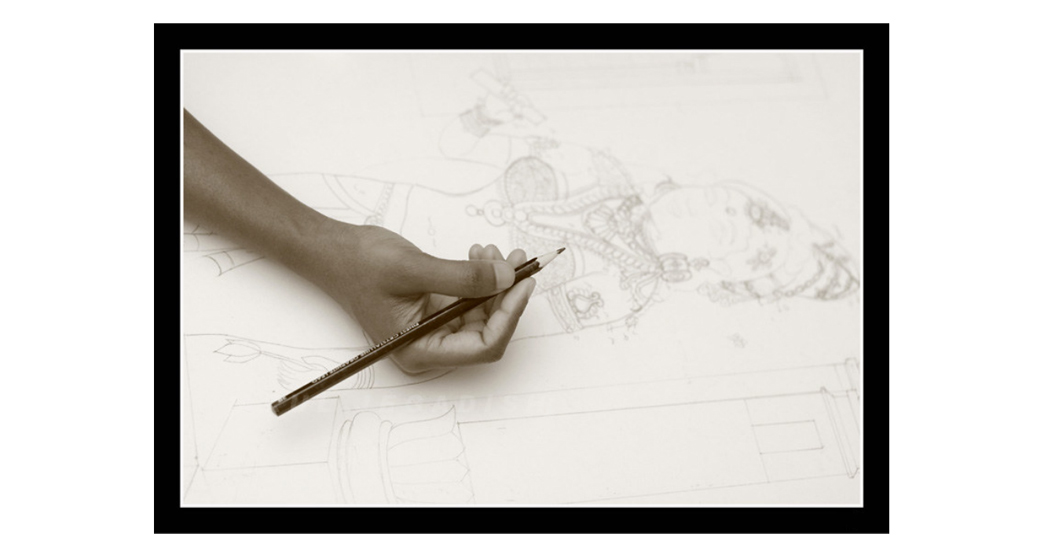
Drawing the Deity
Creating an image of the deity that the artist wants to depict in a painting.
The sketch is then painted over the prepared canvas using templates of religious themes. The artist begins by sketching the ideal picture of the deity they like to depict in the painting with a pencil. The body contour, jewelry, and attire of the god are all meticulously depicted in every detail.
The basic sketch of the drawing is traced on the board using a carbon sheet. A tracing sheet with pinpricks on the outlines will serve as the template. The fabric board is covered with this tracing sheet, and the artist traces the subject onto the wooden canvas.
The sketch is then painted over the prepared canvas using templates of religious themes. The artist begins by sketching the ideal picture of the deity they like to depict in the painting with a pencil. The body contour, jewelry, and attire of the god are all meticulously depicted in every detail.
The basic sketch of the drawing is traced on the board using a carbon sheet. A tracing sheet with pinpricks on the outlines will serve as the template. The fabric board is covered with this tracing sheet, and the artist traces the subject onto the wooden canvas.
Creating Embossing Effect
Glue and chalk powder paste are combined with water, gold paint, and other ingredients to create molding paste. The paste is then loaded into a squeezing cone. The drawing was then recreated by the artist using this paste cone. This paste coats every line on the drawing. Layers of the paste are applied to create a raised effect for the chosen areas of the work. Using paste, some additional elements are added to the painting, such as jewelry embellishments and fabric and crown detailing.
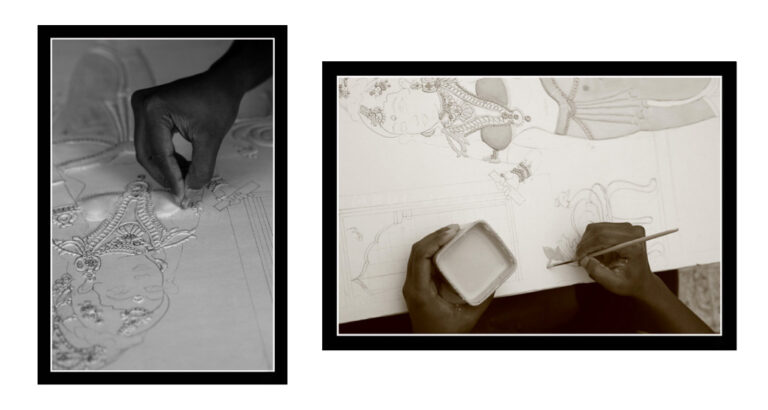
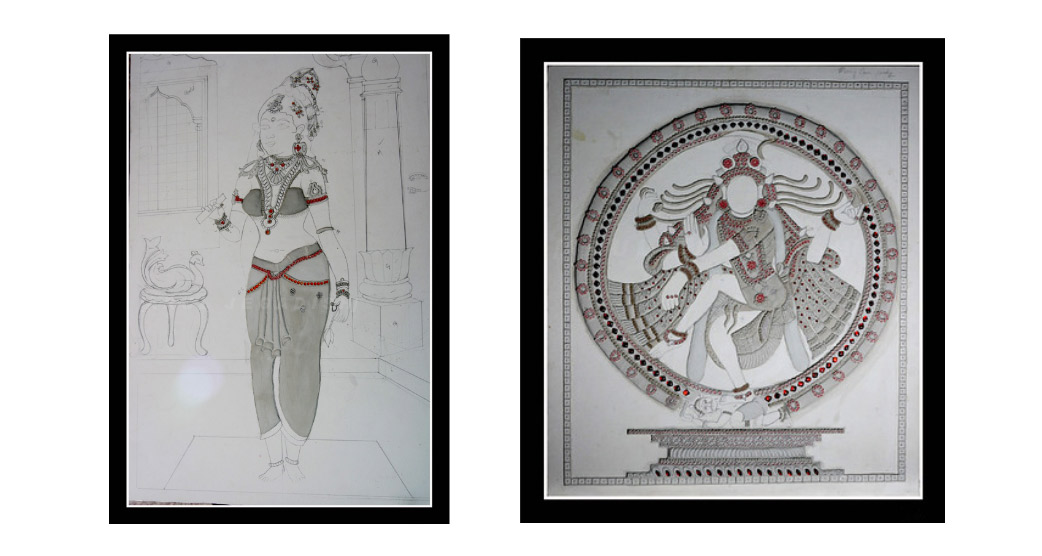
Adding Semi-Precious Stones
After applying the paste to the drawing and creating an embossing effect the artists adhere to the semi-precious stones. They are added on the crown, and on the jewelry like bangles, necklace, earrings, and on waistbands, etc. once the stones are glued to the painting once again the artist uses the chalk paste to add more details to the painting like the border.
Applying The Gold Foil
The artist begins pasting the gold foil on the painting after adding semi-precious stones and finishing the last details with paste. Gold foil is applied to the required areas, such as the jewelry of the deity and on the border. The gold foil gives Tanjore paintings a royal look.
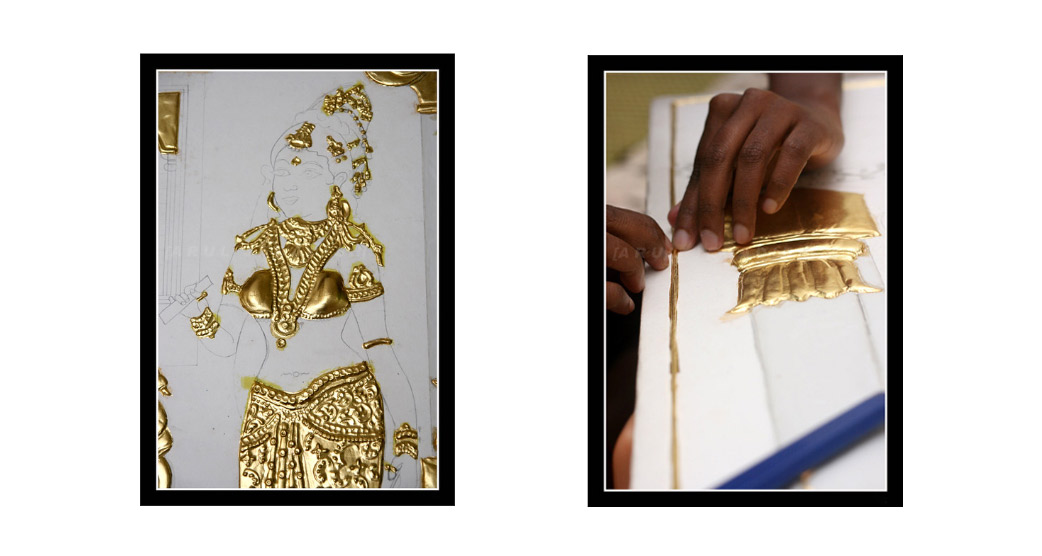
Adding Color To The Tanjore Painting
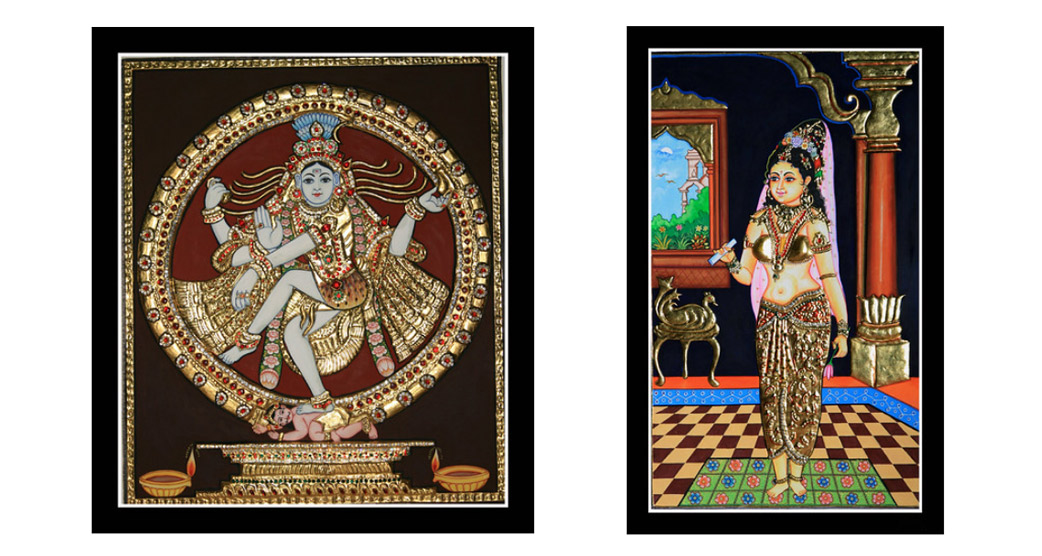
The painting is allowed to dry after the process of adding stones and gold foil is complete. Then, the painter adds color to the painting. The picture is given a pleasing appearance by the use of vibrant colors. These Tanjore paintings have the power to instantly change any regular environment into a lavish, regal atmosphere by simply being there. A well-done Tanjore artwork has such majesty.
Finally, the Tanjore paintings are completed after three to four days of hard work. To make a superb Tanjore painting, the artist must have patience and expertise. Tanjore paintings are a significant type of traditional South Indian art. These paintings are renowned for their beauty, vibrant, stunning colors, and use of gold foil.
Finally, the Tanjore paintings are completed after three to four days of hard work. To make a superb Tanjore painting, the artist must have patience and expertise. Tanjore paintings are a significant type of traditional South Indian art. These paintings are renowned for their beauty, vibrant, stunning colors, and use of gold foil.




